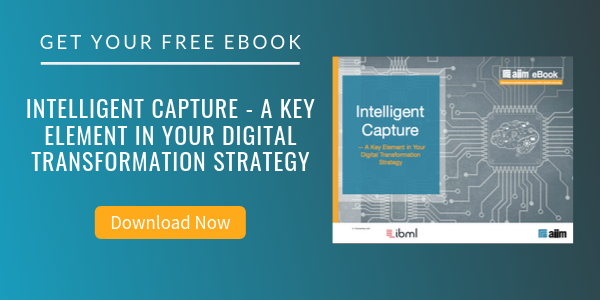/Incorporating%20Intelligent%20Capture%20in%20Your%20Digital%20Transformation%20Strategy%20Landing%20Page%20Header.png)
Capture? Haven't we been doing this for years?
Capture? Haven’t we been doing this for years and years?
Well…yes and no.
Yes, organizations have been scanning paper into digital archives for a long time. And for 72% of organizations, scanning paper is still the most important part of their information capture strategy. The continued importance of simply getting rid of the paper is not just a function of laggard organizations; the struggle to get rid of paper is consistent across all levels of overall competence.
The good news is that organizations do understand that “capture” can be so much more than just scanning paper; they just need to act on this knowledge. While getting rid of the paper and/or digitizing it is a necessary part of Digital Transformation, on its own this is no longer sufficient to truly transform business processes. The evolution from a focus on scan-to-archive to one focusing on scan-to-process is a continuing one, and intelligent capture technologies are tightly connected to this evolution.
The focus of information capture has shifted for 68% of organizations from something that is often done after the fact (often for archiving purposes) to something that is done much closer to the point of information creation (largely for information entering from outside the organization) – as part of the launch of a business process. There is a clear divergence on this point between leaders and laggards. 80% of leading organizations agree that the focus of their information capture efforts “has shifted dramatically toward the point at which information is created.” Only 43% of lagging organizations feel similarly.
AIIM’s new eBook looks at how to create an intelligent capture strategy and the implications this carries for automating document-intensive workflows. For purposes of this research, we asked survey participants to use this definition of Intelligent Capture:
Intelligent capture software automates the scanning and capturing of critical paper and electronic documents – such as invoices, contracts, claims, receipts and shipment documents – replacing manual input and processing. The captured content is then stored in an organized manner, complete with metadata and classification. Once all that information is organized, it is analyzed and automatically processed using AI and analytics platforms.
There are at least eight – likely many more! – benefits of adopting a strategic approach to intelligent capture:
- Reduced labor costs
- Reduced knowledge worker drudgery
- Increased accuracy
- Increased process velocity and efficiency
- Improved compliance and audibility
- Reduced integration problems
- Set the stage for AI and Machine Learning
- Process consistency
As noted, adoption and utilization rates for these technologies vary widely. And so, we focus on four best practices in this eBook that can provide a roadmap for fully utilizing intelligent capture:
- Best Practice #1 – Once you get capture basics in place – more of a wish than a reality in most organizations – adopt a “land and expand” approach to intelligent capture.
- Best Practice #2 – Thoroughly understand the problem set that intelligent capture can help address, and frame conversations in terms of problems to be solved rather than technologies to be deployed.
- Best Practice #3 – Look “downstream” and understand the far-reaching implications that intelligent capture has on process efficiency and automation.
- Best Practice #4 – Review the capabilities of your current and planned capture platforms to make sure they are evolving to meet the next generation of AI and Machine Learning challenges.
About John Mancini
John Mancini is the President of Content Results, LLC and the Past President of AIIM. He is a well-known author, speaker, and advisor on information management, digital transformation and intelligent automation. John is a frequent keynote speaker and author of more than 30 eBooks on a variety of topics. He can be found on Twitter, LinkedIn and Facebook as jmancini77. Recent keynote topics include: The Stairway to Digital Transformation Navigating Disruptive Waters — 4 Things You Need to Know to Build Your Digital Transformation Strategy Getting Ahead of the Digital Transformation Curve Viewing Information Management Through a New Lens Digital Disruption: 6 Strategies to Avoid Being “Blockbustered” Specialties: Keynote speaker and writer on AI, RPA, intelligent Information Management, Intelligent Automation and Digital Transformation. Consensus-building with Boards to create strategic focus, action, and accountability. Extensive public speaking and public relations work Conversant and experienced in major technology issues and trends. Expert on inbound and content marketing, particularly in an association environment and on the Hubspot platform. John is a Phi Beta Kappa graduate of the College of William and Mary, and holds an M.A. in Public Policy from the Woodrow Wilson School at Princeton University.



